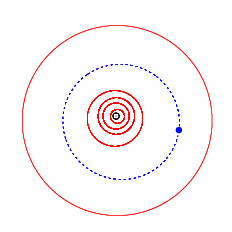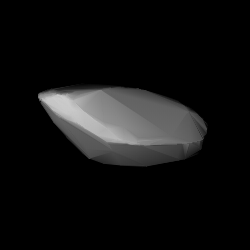Related Research Articles
865 Zubaida is an elongated, stony background asteroid from the inner regions of the asteroid belt. It was discovered on 15 February 1917, by astronomer Max Wolf at the Heidelberg Observatory in southwest Germany, and given the provisional designations A917 CH and 1917 BO. The uncommon L-type asteroid has a rotation period of 11.4 hours and measures approximately 17 kilometers in diameter. It was named after Zobeide, a character in the opera Abu Hassan by Carl Maria von Weber (1786–1826).

Gaussia, provisional designation 1923 OA, is a dark background asteroid from the outer regions of the asteroid belt, approximately 73 kilometers in diameter. It was discovered on 8 August 1923, by Soviet astronomer Sergey Belyavsky at the Simeiz Observatory on the Crimean peninsula. The asteroid was named after German mathematician Carl Friedrich Gauss. Gauss computed the orbit of Ceres, and 1001 Gaussia was named along with 1000 Piazzia, and 1002 Olbersia in part for their work on Ceres, with names for Giuseppe Piazzi, who found Ceres, and Heinrich Wilhelm Matthias Olbers, who recovered it later that year.
Arago, provisional designation 1923 OT, is a dark asteroid from the outer regions of the asteroid belt, approximately 55 kilometers in diameter. It was discovered on 5 September 1923, by Russian astronomer Sergey Belyavsky at the Simeiz Observatory on the Crimean peninsula. The asteroid was named after French mathematician François Arago.
Pawlowia, provisional designation 1923 OX, is a background asteroid from the central regions of the asteroid belt, approximately 20 kilometers in diameter. It was discovered on 5 October 1923, by Soviet astronomer Vladimir Albitsky at the Simeiz Observatory on the Crimean peninsula. The asteroid was named after Russian physiologist and Nobelist Ivan Pavlov.
1024 Hale, provisional designation A923 YO13, is a carbonaceous background asteroid from the outer regions of the asteroid belt, approximately 45 kilometers (28 miles) in diameter. The asteroid was discovered on 2 December 1923, by Belgian–American astronomer George Van Biesbroeck at the Yerkes Observatory in Wisconsin, United States. It was named for American astronomer George Ellery Hale. The dark C-type asteroid may have a rotation period of 16 hours.
1057 Wanda, provisional designation 1925 QB, is a carbonaceous background asteroid from the outer region of the asteroid belt, approximately 43 kilometers in diameter. It was discovered by Grigory Shajn at the Simeiz Observatory in 1925, and later named after Polish–Soviet writer Wanda Wasilewska. The asteroid has a rotation period of 28.8 hours.
1062 Ljuba, provisional designation 1925 TD, is a carbonaceous background asteroid from the outer regions of the asteroid belt, approximately 58 kilometers in diameter. The asteroid was discovered on 11 October 1925, by Soviet–Russian astronomer Sergey Belyavsky at the Simeiz Observatory on the Crimean peninsula. It was named after female paratrooper Ljuba Berlin, who died at an early age. The C-type asteroid has a longer-than average rotation period of 33.8 hours.
1112 Polonia, provisional designation 1928 PE, is an Eoan asteroid from the outer regions of the asteroid belt, approximately 38 kilometers in diameter. Discovered by Soviet astronomer Pelageya Shajn at Simeiz in 1928, it was the first asteroid discovery made by a woman. The L-type asteroid has a long rotation period of 82.5 hours, and was named for the country of Poland.
1113 Katja, provisional designation 1928 QC, is a background asteroid from the outer regions of the asteroid belt, approximately 39 kilometers in diameter. It was discovered by Pelageya Shajn at the Simeiz Observatory in 1928, and named after Ekaterina Iosko, a staff member at the discovering observatory.

1118 Hanskya is a large background asteroid, approximately 77 kilometers in diameter, located in the outer regions of the asteroid belt. Discovered by Sergey Belyavsky and Nikolaj Ivanov in 1927, it was named after Russian astronomer Aleksey Hansky. The presumed dark C-type asteroid has a rotation period of 15.6 hours.
1149 Volga, provisional designation 1929 PF, is a dark background asteroid from the outer regions of the asteroid belt, approximately 55 kilometers in diameter. It was discovered on 1 August 1929, by Soviet astronomer Evgenij Skvorcov at the Simeiz Observatory on the Crimean peninsula. The asteroid was named after the Volga River.

1677 Tycho Brahe, provisional designation 1940 RO, is a stony Marian asteroid from the central region of the asteroid belt, approximately 12 kilometers in diameter. It was discovered on 6 September 1940, by Finnish astronomer Yrjö Väisälä at Turku Observatory in Southwest Finland. The common stony S-type asteroid has a short rotation period of 3.89 hours. It was later named after Tycho Brahe, one of the fathers of astronomy.
1227 Geranium, provisional designation 1931 TD, is a carbonaceous background asteroid from the outer regions of the asteroid belt, approximately 46 kilometers in diameter. It was discovered on 5 October 1931, by German astronomer Karl Reinmuth at the Heidelberg-Königstuhl State Observatory. The asteroid was named for the flowering plant Geranium (cranesbills).
2726 Kotelnikov, provisional designation 1979 SE9, is a stony Koronian asteroid from the outer regions of the asteroid belt, approximately 10 kilometers (6.2 miles) in diameter. It was discovered on 22 September 1979, by Soviet astronomer Nikolai Chernykh at the Crimean Astrophysical Observatory in Nauchnij on the Crimean peninsula. The S-type asteroid has a rotation period of 4.91 hours and is a suspected binary system. The asteroid was named for Soviet scientist and pioneer in radar astronomy, Vladimir Kotelnikov.
1434 Margot, provisional designation 1936 FD1, is a stony Eoan asteroid from the outer regions of the asteroid belt, approximately 29 kilometers in diameter. It was discovered on 19 March 1936, by Soviet astronomer Grigory Neujmin at the Simeiz Observatory on the Crimean peninsula. The asteroid was named after Gertrud Margot Görsdorf, a friend of German astronomer of Wilhelm Gliese.
2443 Tomeileen, provisional designation A906 BJ, is a stony Eoan asteroid from the outer regions of the asteroid belt, approximately 32 kilometers in diameter. It was discovered on 24 January 1906, by German astronomer Max Wolf at the Heidelberg-Königstuhl State Observatory in Heidelberg, Germany. The S-type asteroid was named after the parents of British astronomer Brian G. Marsden. It has a rotation period of 3.97 hours.
1585 Union, provisional designation 1947 RG, is a dark background asteroid from the outer regions of the asteroid belt, approximately 52 kilometers in diameter. It was discovered on 7 September 1947, by South African astronomer Ernest Johnson at the Union Observatory in Johannesburg, South Africa. The asteroid was named after the discovering observatory.
2301 Whitford, provisional designation 1965 WJ, is a background asteroid from the outer regions of the asteroid belt, approximately 17 kilometers in diameter. It was discovered on 20 November 1965, by astronomers of the Indiana Asteroid Program at Goethe Link Observatory in the United States. The asteroid was named for American physicist and astronomer Albert Whitford. The uncommon L-type asteroid has a rotation period of 14.3 hours.

1289 Kutaïssi is a stony Koronian asteroid from the outer region of the asteroid belt. Discovered by Grigory Neujmin at Simeiz Observatory in 1933, it was later named after the Georgian city of Kutaisi. The S-type asteroid has a rotation period of 3.6 hours and measures approximately 22 kilometers in diameter.
10046 Creighton, provisional designation 1986 JC, is a carbonaceous background asteroid from the inner regions of the asteroid belt, approximately 10 kilometers in diameter. It was discovered on 2 May 1986, by astronomers with the International Near-Earth Asteroid Survey (INAS) at Palomar Observatory, California, in the United States. The C-type asteroid has a rotation period of 6.57 hours. It was named after American architect James M. Creighton.
References
- 1 2 3 4 "1059 Mussorgskia (1925 OA)". Minor Planet Center. Retrieved 26 March 2018.
- 1 2 3 Schmadel, Lutz D. (2007). "(1059) Mussorgskia". Dictionary of Minor Planet Names – (1059) Mussorgskia. Springer Berlin Heidelberg. p. 91. doi:10.1007/978-3-540-29925-7_1060. ISBN 978-3-540-00238-3.
- 1 2 3 4 "JPL Small-Body Database Browser: 1059 Mussorgskia (1925 OA)" (2018-02-25 last obs.). Jet Propulsion Laboratory . Retrieved 26 March 2018.
- 1 2 3 4 5 6 7 8 9 10 "LCDB Data for (1059) Mussorgskia". Asteroid Lightcurve Database (LCDB). Retrieved 26 March 2018.
- 1 2 "Asteroid 1059 Mussorgskia – Proper Elements". AstDyS-2, Asteroids – Dynamic Site. Retrieved 28 October 2019.
- 1 2 3 4 Nugent, C. R.; Mainzer, A.; Bauer, J.; Cutri, R. M.; Kramer, E. A.; Grav, T.; et al. (September 2016). "NEOWISE Reactivation Mission Year Two: Asteroid Diameters and Albedos". The Astronomical Journal. 152 (3): 12. arXiv: 1606.08923 . Bibcode:2016AJ....152...63N. doi: 10.3847/0004-6256/152/3/63 .
- 1 2 3 4 Usui, Fumihiko; Kuroda, Daisuke; Müller, Thomas G.; Hasegawa, Sunao; Ishiguro, Masateru; Ootsubo, Takafumi; et al. (October 2011). "Asteroid Catalog Using Akari: AKARI/IRC Mid-Infrared Asteroid Survey". Publications of the Astronomical Society of Japan. 63 (5): 1117–1138. Bibcode:2011PASJ...63.1117U. doi: 10.1093/pasj/63.5.1117 . (online, AcuA catalog p. 153)
- 1 2 3 Masiero, Joseph R.; Grav, T.; Mainzer, A. K.; Nugent, C. R.; Bauer, J. M.; Stevenson, R.; et al. (August 2014). "Main-belt Asteroids with WISE/NEOWISE: Near-infrared Albedos". The Astrophysical Journal. 791 (2): 11. arXiv: 1406.6645 . Bibcode:2014ApJ...791..121M. doi:10.1088/0004-637X/791/2/121. S2CID 119293330.
- 1 2 3 4 Mainzer, A.; Grav, T.; Masiero, J.; Hand, E.; Bauer, J.; Tholen, D.; et al. (November 2011). "NEOWISE Studies of Spectrophotometrically Classified Asteroids: Preliminary Results". The Astrophysical Journal. 741 (2): 25. arXiv: 1109.6407 . Bibcode:2011ApJ...741...90M. doi:10.1088/0004-637X/741/2/90. S2CID 35447010.
- 1 2 Brincat, S. H. (December 2002). "Lightcurve Photometry of Asteroid 1059 Mussorgskia". The Minor Planet Bulletin. 29: 67. Bibcode:2002MPBu...29...67B . Retrieved 26 March 2018.
- 1 2 Behrend, Raoul. "Asteroids and comets rotation curves – (1059) Mussorgskia". Geneva Observatory. Retrieved 26 March 2018.
- 1 2 Veres, Peter; Jedicke, Robert; Fitzsimmons, Alan; Denneau, Larry; Granvik, Mikael; Bolin, Bryce; et al. (November 2015). "Absolute magnitudes and slope parameters for 250,000 asteroids observed by Pan-STARRS PS1 - Preliminary results". Icarus. 261: 34–47. arXiv: 1506.00762 . Bibcode:2015Icar..261...34V. doi:10.1016/j.icarus.2015.08.007. S2CID 53493339 . Retrieved 26 March 2018.
- ↑ Schmadel, Lutz D. (2009). "Appendix – Publication Dates of the MPCs". Dictionary of Minor Planet Names – Addendum to Fifth Edition (2006–2008). Springer Berlin Heidelberg. p. 221. doi:10.1007/978-3-642-01965-4. ISBN 978-3-642-01964-7.